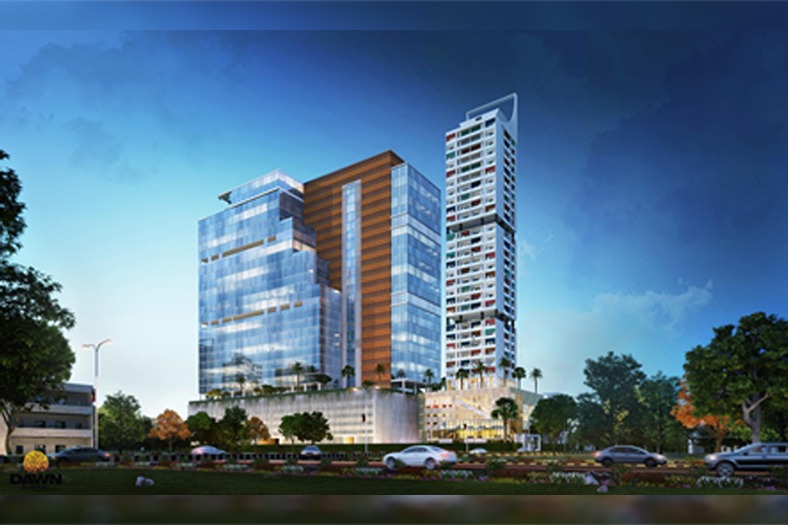Simplified HVAC systems for better environment

A comprehensive analysis on why HVAC systems are principle elements in building automation
Why HVAC system is essential?
HVAC systems form the backbone of building automation as they play an important role in controlling the building environment. Essentially it is a system of controlling temperature, humidity, and air quality in indoor spaces.
Speaking on the importance of HVAC systems in the building, Kamal Singh, Sales Director, Danfoss Drives, India says, “The goal of an HVAC system is to provide an acceptable level of indoor air quality and thermal comfort. The system’s designs are based on the principles of heat-transfer, thermodynamics, and fluid mechanics. HVAC equipment take up a large chunk, almost 60 per cent, of energy consumption in a building.”
Building automation is a principle tool for monitoring and controlling the services within a building. The HVAC system is spread across the building and handle variety of functions unlike other utilities in the building. Avinash Pandit, President, Mechanical Solutions Sterling and Wilson Pvt Ltd considers that HVAC systems is very crucial building automation. An air-conditioning system needs to be controlled by every end-user, as well as centrally, for effective energy monitoring. There are various ventilation and life-safety systems, which are independent standalone apart from AC example toilet exhaust, parking exhaust, various plant room exhaust and life safety smoke exhaust and pressurisation systems. “The other utilities like water treatment, sewage system and generators are located in one part of the building and can easily be operated from their own standalone systems. Building automation is essential aggregator of spread of the HVAC systems in the building,” Pandit adds.
With increased focus on total cost of ownership the efficiency of commercial buildings is coming under increased focus. The building industry has only begun to tap these “energy cash opportunity” trapped in underperforming facilities. In future a wide range of groundbreaking innovations in high performance building technologies, operating practices and intelligent building services that will create better, healthier, more comfortable and productive indoor environments.
In terms of opportunity in potential terms in optimising total life cycle cost of ownership, 25 per cent of the buildings life cycle is finance and construction costs wherein 75 per cent of cost of building life cycle cost is operational. On this note, Sudarshan Ananth, Vice President, Emerging Market and India, Asia Pacific and India HVAC & Transport, Ingersoll Rand states, “With 58 per cent of the energy consumption in a standard building on account of HVAC system makes it an attractive to focus on for building infrastructure owners and operators.”
Ananth adds that there are many strategies one can adopt to manage efficiency and cost in a building infrastructure but building automation strategy is known to save up to 30 per cent of the energy savings with the major chunk coming from automation of HVAC systems. It is an effective device level monitoring that helps in modulating fluctuation in occupancy and system capacities to effectively deliver the cooling load at most optimum cost.
Benefits of HVAC control systems
HVAC is the biggest consumer of energy in a building. It is also necessary service which makes modern buildings possible. It is impossible to imagine a hotel or a hospital nowadays without HVAC. On this note, Pandit says, “HVAC consumption is dependent on variety of factors which vary real time. For example the climatic conditions and occupancies. Even within a building there is a variation in user preferences in comfort. Hence, the only way to optimise the energy is to micro control the end points of consumption to get an aggregated advantage at the central plant; this is not possible without reliable control system.”
“In today’s changing climate and economy, managing and minimising energy usage in commercial and residential buildings is beneficial not only to environment, but also to the economy. HVAC control systems overall help in controlling energy usage and thereby significantly lowering operating costs,” states Singh.
For Instance Singh adds, “Danfoss Turbocor, an innovation from Danfoss, is a high efficiency oil-free centrifugal compressor that can provide extremely high energy savings for HVAC systems. It can reduce up to 35 to 50 per cent of energy consumption of a commercial HVAC system. . Using a VFD for controlling the compressor speed leads to comfortable indoor environment which will otherwise be too cool or too warm as load varies throughout the day.”
On the other hand, it starts with first creating a smart or measurable infrastructure which must tamper proof to extent possible and measuring the consumption to establish a base line versus design parameters in terms of consumption of energy resources like battery, water, electricity power units, airflow and lighting loads. On this note, Ananth says, ”Ingersoll Rand strongly advocates the convergence model to kick-start smart city dream and start looking at a cohesive way of finding solutions which are innovative.”
Ananth explains some the key benefits of implementing HVAC Control Systems. They are:
• Optimising performance through central monitoring solutions for all discrete and standalone systems. IT enables enterprise wise control in the most intelligent and effective way.
• Saving costs by easing maintenance and optimising usage of utilities and energy. BMS system saves close to 30 per cent of energy consumption.
• Implementing HVAC control systems also provides management dashboard for critical analysis. It also Improved plant reliability and life.
• Data is consolidated on to a single system to improve reporting, information management and decision-making. Integrating and managing the HVAC, energy, security, digital video and life safety applications from a single workstation allows facility-wide insight and control for better performance.
• The powerful combination of open systems protocols and a scalable platform means the BMS can help support growth and expansion of the system in the future.
Complex systems
The more complex HVAC system is, the more difficult it is to maintain it on a day to day basis. “Fault finding and maintenance of multiple equipment in the buildings is a strenuous task and will have direct impact on the people without the right controls. Also HVAC systems directly impact the working conditions and in turn productivity of the working people dependent on that environment,” observes Singh.
Speaking on how complex HVAC systems can complicate the building automation systems, Pandit says, “HVAC systems are spread across the building e.g., the central chillers are at one location but the AHUs and FCUs and various ventilation fans are spread across buildings. Building automation system works on installing smaller controllers in a network at various locations in building to capture data from various equipment and relay it to central computer wherein the data is processed and instructions are issued.”
To avoid this complexity, Pandit also suggests, “A complex building or multiple buildings provide challenges for building such a network. There are various solutions like a fibre optic cable network and advanced IP systems which can be employed to overcome such challenges.”
Ananth highlights some of the key factors that can complicate the building automation system as:
• Having too much integration (with large data points) can complicate the BAS (Building Automation System) systems.
• Not having a clear point summary or sequence of operation (SOP) can really complicate the BAS system by not delivering the real advantages that BAS can offer.
• Not using the BAS system religiously after the systems are commissioned can undermine the BAS advantages. Simplifying the problems Any problem has its solution, how may ever the complex is the situation it can be solved with certain solutions. Same applies to complex HVAC systems that can complicate the building automation systems but it can also be solved.
On providing solutions to the complex HVAC systems that can complicate building automation system, Pandit suggests, “An integrated design approach is essential. Most network systems can be simplified by identifying the I/O points in each area and designing controllers to take care of it and hence avoiding duplication. Also designers need to finalise the control philosophy simultaneously when they design the process to avoid abortive and corrective modifications in the system. Client also needs to play an important role by participating and understanding control philosophy in advance to avoid corrective suggestions later. Overall if all stakeholders invest a little time and effort in design stage the system will be effective and deliver the function of optimising the energy along with operating comfort to building owners and property managers.”
Key to success of this system is to keep the metric traceable, measureable and recordable. The tamper proofing, the system makes it reliable as system gathers data, and analysis. On this note Ananth points out some of the ways to simplify the problems. He suggests, “Calibration of sensors and gauges are necessary to make input is reliable. Clearly define the point summary and the sequence of operation for each and every equipment. Constantly use BAS system (once commissioned) in auto mode and disable switch to manual modes. Regular review of dashboards will help benchmark for efficient and effective usage. Use standard operating practises and standards to review the reports.
HVAC controls have been developed which help communicate with peripheral equipment, thereby helping with easy maintenance of the entire system. “Products such as EL, Drives and Controls help in simplifying the HVAC systems and also reducing power consumption. Also a system becomes more efficient and reliable when we reduce the manual interference and increase automation. This automation leads to energy optimisation as well as lowest total cost of ownership, says Singh.
Conclusion
HVAC system is considered to be the backbone of the building automation due to its qualities that provides fresh air, controlling the temperature, controlling the building environment. Hopefully, In the near future, there will be advanced HVAC systems that will simplify the complex building automation systems.
——
Building automation is essential aggregator of spread of the HVAC systems in the building.Avinash Pandit, President, Mechanical Solutions Sterling and Wilson Pvt. Ltd.
——
HVAC equipment take up a large chunk, almost 60 per cent, of energy consumption in a building.Kamal Singh, Sales Director, Danfoss Drives, India.
——
With 58 per cent of the energy consumption in a standard building on account of HVAC system makes it an attractive to focus on for building infrastructure owners and operators.Sudarshan Ananth, VP, Emerging Market and India, Asia Pacific and India HVAC & Transport, Ingersoll Rand
38
Cookie Consent
We use cookies to personalize your experience. By continuing to visit this website you agree to our Terms & Conditions, Privacy Policy and Cookie Policy.









